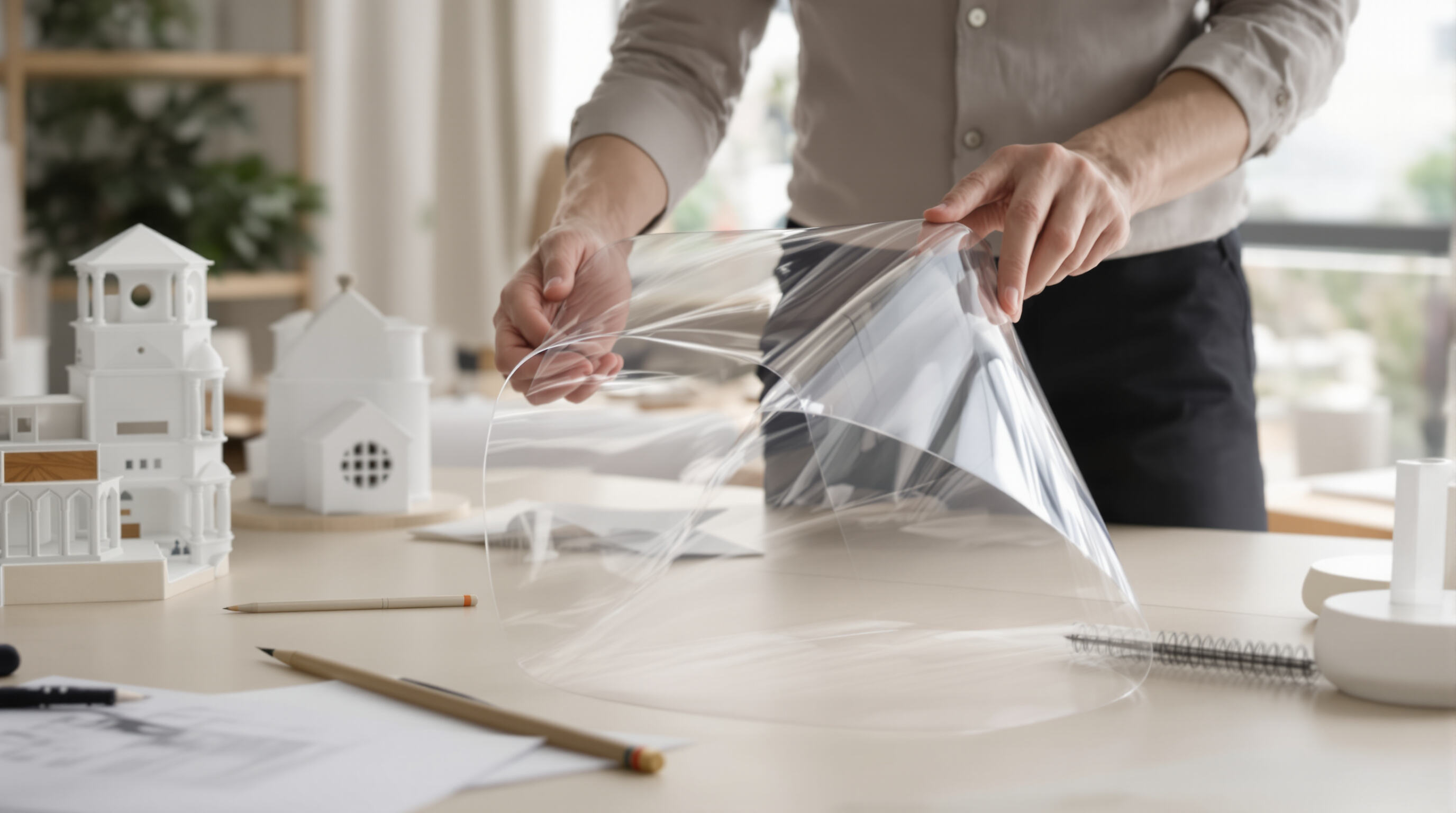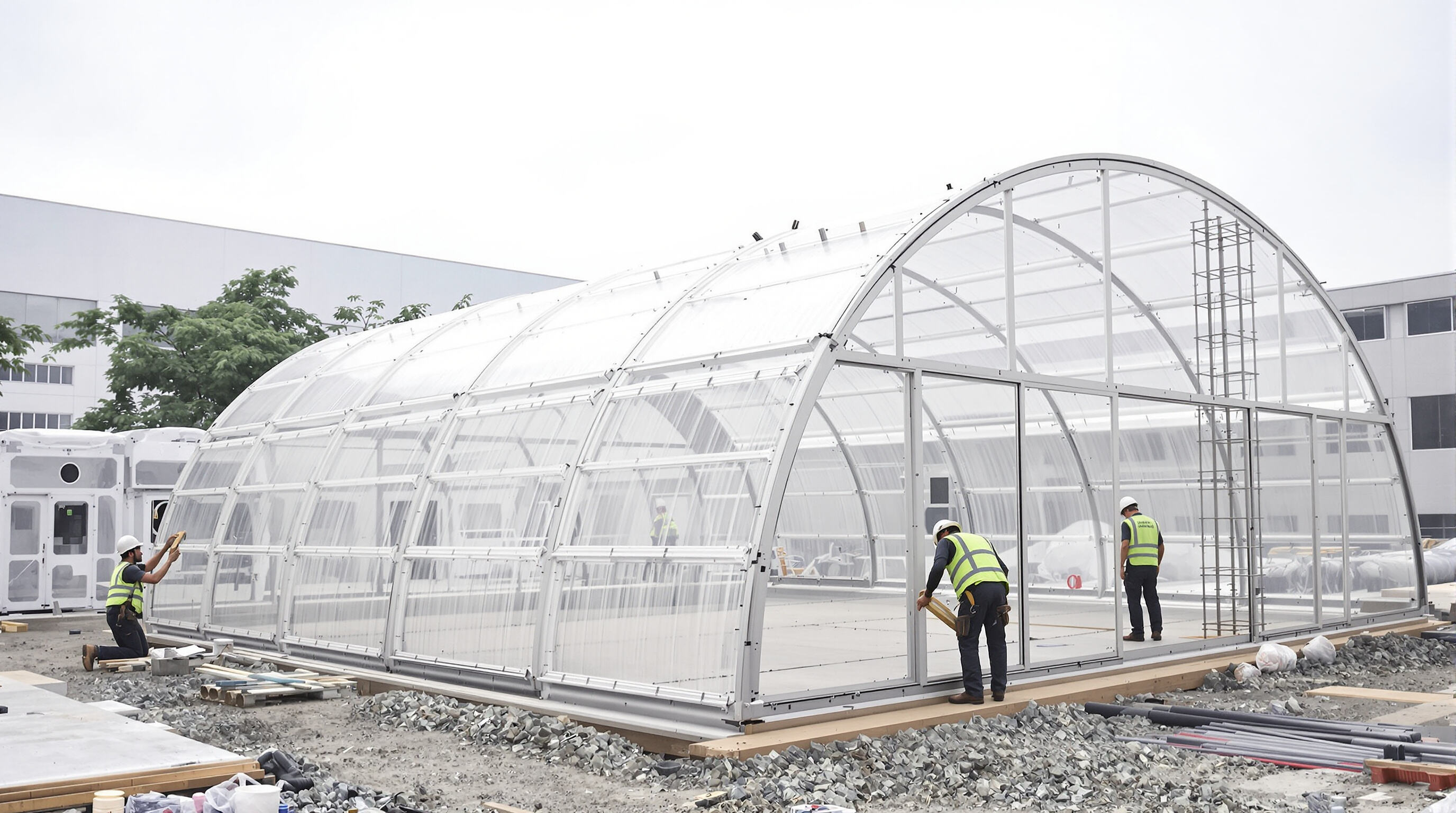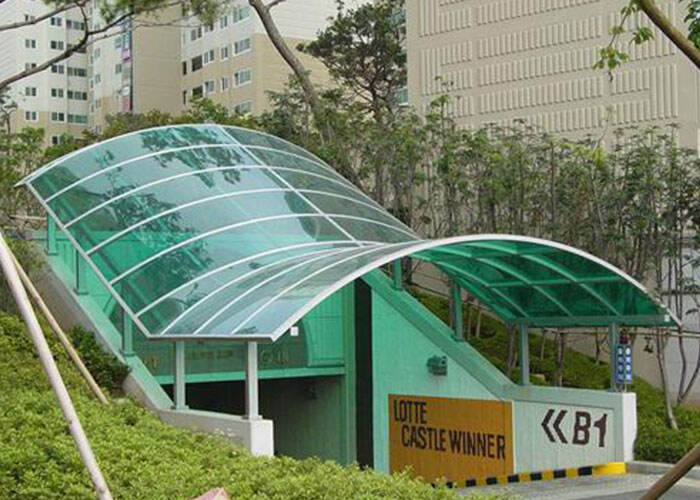Bərk Polikarbonat Vərəqin Dizayn Elastikliyi

Modern Dizaynda Bərk Polikarbonat Vərəqlərin Memarlıq Tətbiqləri
Polikarbonat vərəqlər indi müasir tikinti dizaynında praktik olaraq vacib hesab olunur, memarların görünüşü möhkəmliklə birləşdirməsinə imkan verir. Bu vərəqlər əlavə dəstək olmadan böyük sahələri örtə bilir, buna görə də tradision materiallarla üzləşə bilməyəcəyimiz işıqlıqlar, binaların xarici tərəfi və ya əyri dam örtükləri kimi şeylər üçün əla işləyir. Rəqəmlər isə bunu təsdiqləyir - polikarbonatın möhkəmliyi sənaye tədqiqatları nəticəsində adi şüşədən təxminən 250 dəfə yaxşıdır. Belə davamlılıq isə dizaynerlərin yeraltı təhlükəsi olan ərazilərdə və ya insanların çox olduğu və təhlükəsizliyin ən çox vacib olduğu yerlərdə şəffaf binalar üçün istifadə etdiyini izah edir.
Fərdi konstruksiyalar üçün Bərk Polikarbonat Vərəqlərinin Formalaşdırılması və Modelə Edilməsi
Qatı polikarbonat vərəqət sərt alternativlərdən fərqli olaraq soyuq istiqamətləndirilə bilər və ya termoformalma yolu ilə mürəkkəb həndəsi formalar yaradıla bilər - dalğalı dam örtükləri və ya hiperbolik paraboloid fasadlar kimi. Bu formala bilənlik şüşəyə nisbətən 18-22% istehsal tullantılarını azaldır (Sustainable Building Journal 2023), həmçinin UV müqaviməti və istilik izolyasiyası kimi əsas performans göstəricilərini saxlayır.
Estetik müxtəliflik üçün rəng və emaye seçimləri
Materialın çoxcəhətli istifadəsi 30-dan çox standart rəng seçimini əhatə edir - şəffaf şəkildən şüşələnmiş opal emaye növünə qədər - və metalın sürtünməsi və ya prizmatik naxışları təqlid edən xüsusi toxunalar. 2023-cü ildə Architectural Materials Today tədqiqatı göstərdi ki, dizaynerlərin 78%-i günəş əks etdirməsi 85% və estetik nəzarət tələb edən layihələr üçün polikarbonatı prioritet hesab edir.
Fəzanın восприятие artırmaq üçün işıq keçiriciliyi xassələri
12%-dən 92%-ə qədər tənzimlənə bilən işıq diffuziya dərəcələri ilə bərk polikarbonat təbəqə görünən işığın 88%-ə qədərini ötürərkən parıltısız interyer yaradır. Bu, gün işığının optimallaşdırılması tədqiqatlarında ikiqat şüşəli şüşəni 15% üstələyir (Building Science Corp. 2023), muzeylər və atriumlar kimi enerji baxımından neytral məkanları təmin edir.
Estetika və Performansın Balanslaşdırılması: Qavranılan Dizayn Məhdudiyyətlərinin Həlli
Əvvəlki polikarbonat lövhələr səthi xətlənmələr səbəbiylə tənqid edilsə də, inkişaf etmiş sərt qat texnologiyaları artıq qabığsız variantlardan 10 dəfə daha çox aşınma müqaviməti təmin edir (Material Innovation Institute, 2023). 40% toz yapışmasını azaldan antistatik emal ilə birləşdirildikdə, bu inkişaf davamlılıq və dizayn aydınlığı arasında tarixi kompromisləri aradan qaldırır.
Konstruktiv Performans və Davamlılıq Üstünlükləri
Bərk Polikarbonat Lövhənin Şüşə və Akrilə Nisbətən Yüksək Təsirə Müqaviməti
Müqavimət baxımından köhnə məktəb materiallarına nisbətən bərk polikarbonat vərəqlər həqiqətən də fərqlənir. Testlər onun göstərir ki, onlar ASTM D256-23 standartlarına əsasən adi şüşəyə nisbətən təxminən 200 dəfə yaxşı və akril plastikdən təxminən 30 dəfə daha güclü şəkildə təsirləri dəstəkləyə bilər. Bu vərəqlərin əsasən heç vaxt qırmayan olması küləkələrə meyilli olan bölgələr, təhlükəsizlik qurğuları və əşyaların gün boyu vurulduğu məşğul mağazalar kimi yerlərdə çox faydalıdır. Şüşə isə fərqlidir, çünki o, qırıldıqda insanların zədələnməsinə səbəb ola biləcək kəskin hissələrə çevrilir. Polikarbonat isə yüklənmə zamanı qırmayaraq əyilir və buna görə də təhlükəsizlik ekspertləri Material Təhlükəsizliyi Hesabatında 2023-cü ildə stadion tavanlarının qırılmasını simulyasiya edən testlərdə onun nə qədər yaxşı işlədiyini gördükdən sonra onu çox təbliğ edirlər.
Ultrabənövşəyi qoruma və ekstremal iqlimlərdə uzunmüddətli hava şəraitinə müqavimət
Bərk polikarbonat üzərində qabarcıqlaşdırılmış UV örtüklər materialın çətin şəraitdə daha uzun müddət dayanmasını təmin edir. Səhra və sahillərdə bir neçə onillik qaldıqdan sonra belə hələ də işıq keçiriciliyi 92% təşkil edir. Bu da 2024-cü ildə aparılan polimer parçalanması araşdırmasına əsasən yalnızca 74% işıq keçirən akrilin üstünlüyünü göstərir. Bu lövhələr həmçinin ekstremal temperaturları da dözə bilir. Onlar dondurucu soyuqlarda və ya 240 Fahrenhayt dərəcə istidə belə formasını saxlayaraq möhkəm qalır. Bütün hərarət dəyişikliklərinə baxmayaraq heç bir deformasiya baş vermir. Bu möhkəmlik səbəbindən istehsalçılar 10 illik tam zəmanət təklif edirlər. Biz hətta Antarktidadakı tədqiqat bazalarında belə bu materiallardan temperatur ekstremallığı gündəlik həyatın bir hissəsi olduğu yerlərdə uğurla istifadə edildiyini gördük.
Mürəkkəb memarlıq qurğularında istifadənin və quraşdırılmanın yaradıcı imkanları
Bərk polikarbonat adi şüşədən üç dəfə çox əyilə bilir ki, bu da onu çətin əyrilmiş binaların fasadları üçün ideal edir. Dubainin Al Maktum Hava Limanı bu yaxşı nümunədir, orada 1,2 mil radiuslu əyrilmiş böyük küləklik quraşdırılıb. Həmçinin, bu material şüşədən yarı qədər ağırdır, buna görə də keçən ilki Arxitektura Mühəndisliyi Jurnalında bildirildiyinə görə memarlar konsolelərin dəstəkləyici konstruksiyaları üçün hər kvadrat fut üçün təxminən 18 dollar qazanır. Əslində isə ən vacib odur ki, onunla sahədə işləmək nə qədər asandır. İnşaatçıların soyuq formalaşdırılmış konstruksiyaları birbaşa tikinti sahəsində hazırlaması üçün xüsusi alətlərə ehtiyac yoxdur və bu, quraşdırma vaxtını ənənəvi temperlənmiş şüşə üsullarına nisbətən təxminən 40% azaldır.
Bərk Polikarbonatın Davamlılığı və Ətraf Mühit Təsiri
Davamlı Tikinti Layihələrində Enerji Səmərəliliyi və Təkrar Emal Edilə bilənlilik
Polikarbonat vərəqlər əslində ətraf mühitə fayda verir, çünki daha yaxşı izolyasiya edir və hətta bir neçə dəfə təkrar emal oluna bilər. Bu materiallardan istifadə edən binalar ənənəvi şüşə pəncərələrlə müqayisədə ümumiyyətlə istilik və soyutma xərclərini təxminən 30% azaldır. Səbəbi nədir? Keçən il PlasticsToday-da bildirildiyinə görə, polikarbonat istiliyi şüşədən təxminən iki dəfə az keçirir. Bu gün istehsalçılar polimerləri emal etmək üçün yeni üsullar inkişaf etdirmişlər ki, belə vərəqlər hətta yeddi dəfədən artıq təkrar istifadə edildikdən sonra belə möhkəm qalsın. Bu da onları tikinti zibilini yığma meydançalarına göndərilən həcmi azaltmaq istəyən ekoloji tikinti layihələri üçün ideal edir. Müasir polikarbonatı əvvəlki plastik variantlardan ayırıcı cəhət ondadır ki, təkrar emal proseslərindən sonra belə şəffaf görünməyə və formasını saxlamaya davam edir. Məktəblər də təbii işıqlanma vacib olduğu, lakin təhlükəsizlik qaydaları standart şüşədən daha möhkəm bir şey tələb etdiyi tədris otaqları üçün bu materialı istifadəyə başlayıblar.
Həyat Mərhələsinin Müqayisəsi: Bərk Polikarbonat Vərəqi vs. Şüşə və Akril
Onilliklər boyu istifadənin ətraf mühitə təsirini qiymətləndirərkən bərk polikarbonat vərəq şüşə və akrilə nisbətən üç əsas sahədə üstünlük təşkil edir:
- İstehsal Enerjisi — Şüşənin istehsalı üçün tələb olunan enerjisinin 60% azına ehtiyac duyur
- Nəqliyyat Emissiyaları — 45% yüngül olması nəqliyyat zamanı yanacaq sərfini azaldır
- Həyatın Sonunda Dəyəri — Akrilin orta recikləmə dərəcəsinin 22%-nə qarşı 100% reciklənə biləndir
Polikarbonatın ilkin emissiyalarını kompensasiya edən 25-dən artıq illik xidmət ömrü var. Dəniz sahillərində və güclü günəş işığı olan ərazilərdə möhkəmliyi əvəzetmə tezliyini azaldır, bu da ömrü boyu emissiyaları və təmir xərclərini aşağı salır — onu davamlı, uzunmüddətli tikintilər üçün ən yaxşı seçim edir.
Müasir İnşaat və Memarlıqda Əsas Tətbiq Sahələri
Təbii işıqlandırma üçün bərk polikarbonatdan istifadə edən tavan pəncərələri və tavan şüşələnməsi
Polikarbonat lövhələr kommersiya binalarında və evlərdə gün işığının istifadəsi ilə bağlı düşüncəmizi dəyişdirir. Bu materiallar görünən işığın təqribən 88%-ni keçirir, lakin Material Effsient Institute tərəfindən 2023-cü ildə aparılan tədqiqatlar nəticəsində UV radiasiyanın 99,9%-ni bloklayır. Əksər memarlar tavan pəncərələri üçün adi şüşəyə nisbətən təqribən 250 dəfə çox təsirlərə davam gətirə bilən və təxminən yarısı qədər ağırlığa malik olan bu materialları üstün tuturlar. Bu isə dəstək konstruksiyalarının qalınlığını və ağır olmasını tələb etməməsi deməkdir. Termal performans baxımından isə çoxqatlı versiyalar xüsusilə fərqlənir. Onlar istilik və soyutma xərclərini ənənəvi şüşələnmiş pəncərələrlə müqayisədə uzun müddətdə təqribən 18%-dən 30%-ə qədər azaldır.
Fasadlar və üzlüklər: möhkəmlik və vizual cəlbedicilik
Bərk polikarbonat üzlük şəhər daxilində 140 mil/saat sürətində küləklərə və hətta iki düymdən böyük olan doluya davam gətirəcək qədər möhkəmdir və çatlamadan çıxış edə bilər. Bu, hər biri bir neçə il sonra yenilənmə tələb edən alüminium kompozit panellərdən fərqlidir. Polikarbonata istehsal zamanı daxil edilmiş UV-mühafizəsi sayəsində rəngləri 15 ildən artıq təzə görünməyə davam edir. Memarlar da son vaxtlar bu materialla bir çox yaradıcı həllərə imza atıblar. Bəzi binalar polikarbonatın elastikliyinə borcludur ki, möcüzəli həndəsi formalar yaradıla bilib, digərlərində isə günəş işığı nə vaxt hansı tərəfdən düşərsə, görünüşünü dəyişən rəngli panellər istifadə edilib.
Yarımşəffaf Polikarbonatla Daxili Partisyenlər və Dinamik Sahələr
Bu material işıqı elə yayır ki, ofis bölmələri açıq görünür, lakin səsi özündə saxlayır və fon səs-küyü təxminən 28 desibeldən azaldır. Bir çox xəstəxanalar artıq bu qübbəvi polikarbonat bölmələrə üstünlük verirlər, çünki onlar asanlıqla təmiz qalır və yüzlərlə dezinfeksiya silkisi dözməyə qadir olurlar. Müasir termoforminq üsulları ilə dizaynerlər indi bir materialdan bütöv üçölçülü konstruksiyalar yarada bilirlər. Fəzalarda axan dalğalı sənət divarları, küncə mükəmməl ətrafını dolanan dairəvi lift qutuları və səthlərdən kənardan keçən daxili işıqlandırma kanalları barədə düşünün. Bu innovasiyalar yalnız yaxşı görünmür, həm də gündəlik istifadədə fəzaların iş funksiyalarını yaxşılaşdırır.
Polikarbonat istifadəsində inkişaf etmiş meyllər və gələcək inkişaf istiqamətləri
Ağıllı inteqrasiya: Fotovoltaik elementlərlə bərk polikarbonat
Bu günün arxitekturları binaların innovasiya olunmuş fasadları və dam örtükləri vasitəsilə öz elektrik enerjisini yaratmasına imkan verən fotovoltaik hüceyrələrlə bərk polikarbonat lövhələri birləşdirirlər. Bu material işıq keçirə bildiyi üçün (təxminən 90% şəffaflıq) belə konstruksiyaların daxilinə solar enerji toplayan elementlərin yerləşdirilməsinə imkan verir. Keçən ilin bəzi tədqiqatları şüşə ilə birləşdirildikdə bu hibrid panellər buludlu və ya dolayı günəşli hava şəraitində adi solar qurğulardan təxminən 18 faiz daha çox enerji istehsal etdiyini göstərmişdir. Yeni tikililər üçün mühəndislər tez-tez solar massivlərinin üzərini qoruyan örtüyə çevriləcək polikarbonat lövhələri lazır ilə kəsirlər. Bu lövhələr təxminən 150 mil/saat sürətli küləklərə davam gətirə bilir və həmçinin solar modulların ümumi çəkisini təxminən 40 faiz azaldır ki, bu da işçilər üçün quraşdırmanı daha asan və təhlükəsiz edir.
Modulyar Sistemlər: 3D-Çap Edilmiş Düyünlər və Hazır Polikarbonat Konstruksiyalar

Memarlıq dünyasında isə 3D çap edilmiş hissələrdən istifadə edərək birləşdirilmiş prefabrikat polikarbonat modulları sayəsində böyük dəyişikliklər baş verir. Keçən ilin Tikinti İnkişafı Hesabatına əsasən, dizaynerlər artıq konstruksiya gərginliyini adi polad armaturdan təxminən 23% yaxşı yaymaq üçün bu xüsusi qovşaq növlərindən istifadə edirlər. Bəzi olduqca maraqlı inkişaf da özünü göstərib. Tikicilərin əyrilikli karnizləri çox daha tez yığmağa imkan verən bu snap fit birləşdiricilər mövcuddur və həqiqətən də yığma vaxtından təxminən 70% qənaət edilir. Şəffaf panelin özü də olduqca təsir bağışlamır, çünki onlar artıq istilik izolyasiyası üçün nəzərdə tutulmuş boşluqlarla gəlir və bu da tikililərdə ümumi istilik və soyutma ehtiyacını azaldaraq HVAC xərclərini təxminən 15% azaldır. Dəqiqlik baxımından isə bu fabriki komponentlər 0,25 mm qədər dəqiq ölçülərə çatır, beləliklə tikinti sahəsində quraşdırma zamanı heç nə tək vaxtında itirilmir. Orta ölçülü layihələr üçün bu yaradım cədvəlindən 30-45 gün qənaət edir və bu, polikarbonatın həm estetik, həm də funksional cəhətdən material kimi sahib olduğu bütün xassələri qurbanlıq vermədən həyata keçirilir.
SSS
Şüşəyə nisbətən polikarbonat vərəqləri nəyə görə belə davamlıdır?
Polikarbonat vərəqlər şüşədən çox daha yaxşı dərəcədə təsirlərə davam gətirir və möhkəmliyi 250 dəfə artıqdır, bu da onları yeraltı təkanlar və yüksək hərəkətli sahələr üçün ideal edir.
Polikarbonat vərəqləri ekstremal iqlimlərdə istifadə edilə bilərmi?
Bəli, polikarbonat vərəqlərin ekstremal temperaturlara davam gətirən UF qatları var və səhra şəraiti və dondurucu temperaturlar kimi qətib ətraf mühit şərtlərində belə davamlılığını saxlayır.
Polikarbonat vərəqlərin istifadəsinin ətraf mühitə hansı faydaları var?
Polikarbonat vərəqləri enerji səmərəlidir, bir neçə dəfə təkrar emal olunur və istilik və soyutma xərclərini azalda bilər, bu da onları davamlı tikinti layihələri üçün uyğun edir.
Polikarbonat vərəqləri memarlıq dizaynının çevikliyinə necə təsir edir?
Bu vərəqlər əyrilikli damlar və fasadlar kimi mürəkkəb həndəsi formalar halına gətirilə bilər, şüşəyə nisbətən istehsal tullantılarını azaldarkən bir çox dizayn seçimləri təqdim edir.
Polikarbonat vərəqlər təbii işıqlandırma üçün uyğundurmu?
Bəli, onlar görünən işığın 88%-ə qədərini keçirir, lakin tamamilə UV radiasiyanı blok edir, bu da onları təbii işıqlandırma tələb olunan günəş pəncərələri və digər tətbiqlər üçün ideal edir.
Mündəricat
-
Bərk Polikarbonat Vərəqin Dizayn Elastikliyi
- Modern Dizaynda Bərk Polikarbonat Vərəqlərin Memarlıq Tətbiqləri
- Fərdi konstruksiyalar üçün Bərk Polikarbonat Vərəqlərinin Formalaşdırılması və Modelə Edilməsi
- Estetik müxtəliflik üçün rəng və emaye seçimləri
- Fəzanın восприятие artırmaq üçün işıq keçiriciliyi xassələri
- Estetika və Performansın Balanslaşdırılması: Qavranılan Dizayn Məhdudiyyətlərinin Həlli
- Konstruktiv Performans və Davamlılıq Üstünlükləri
- Bərk Polikarbonatın Davamlılığı və Ətraf Mühit Təsiri
- Müasir İnşaat və Memarlıqda Əsas Tətbiq Sahələri
- Polikarbonat istifadəsində inkişaf etmiş meyllər və gələcək inkişaf istiqamətləri
-
SSS
- Şüşəyə nisbətən polikarbonat vərəqləri nəyə görə belə davamlıdır?
- Polikarbonat vərəqləri ekstremal iqlimlərdə istifadə edilə bilərmi?
- Polikarbonat vərəqlərin istifadəsinin ətraf mühitə hansı faydaları var?
- Polikarbonat vərəqləri memarlıq dizaynının çevikliyinə necə təsir edir?
- Polikarbonat vərəqlər təbii işıqlandırma üçün uyğundurmu?

